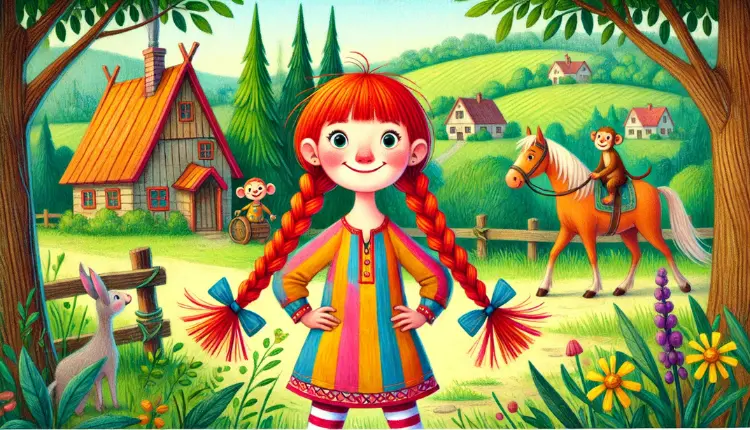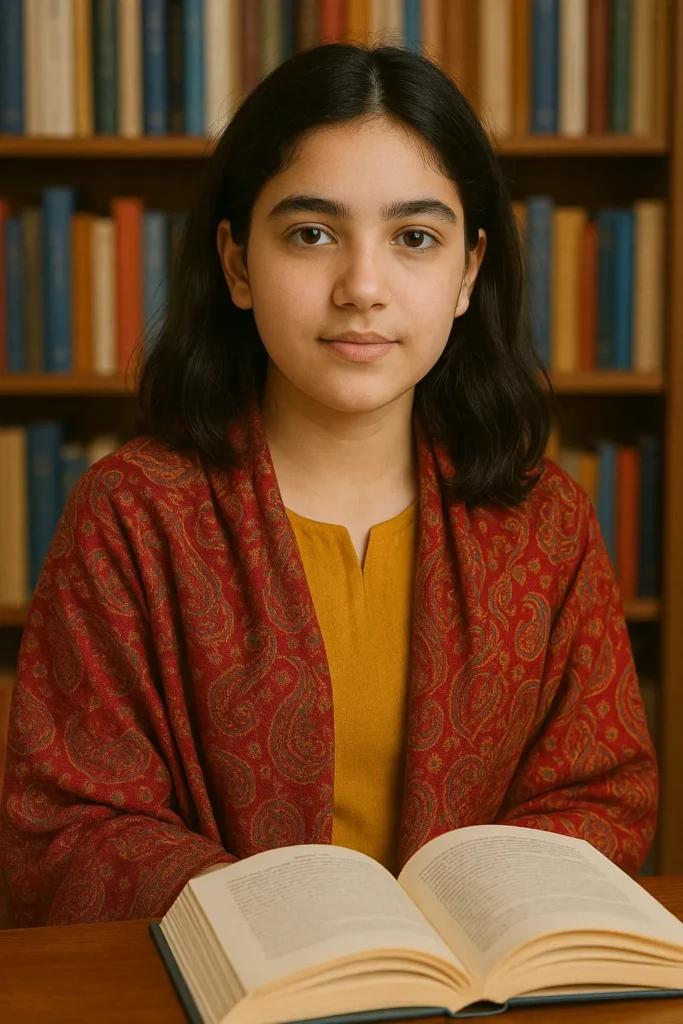In a quiet suburb lined with neat rows of identical houses, a peculiar home stood out like a splash of bright paint on a beige canvas. It was a slightly crooked, ivy-covered house with a brightly painted red door and mismatched window shutters. The mailbox read Villa Villekulla, but most neighbours simply called it “the odd house.” It had stood empty for years—until one summer morning, a girl named Pippi Longstocking moved in.
Pippi wasn’t like any other eleven-year-old in the neighbourhood. For starters, she had no parents with her, just a pet monkey named Mr. Nilsson and a horse that lived comfortably on the back porch. Her hair, a fiery red, was braided into two stiff pigtails that stuck out like antennae, and her clothes looked as though she had pieced them together from a thrift store’s discount bin.
Nobody knew much about her arrival. Rumour had it that her father was a sailor who had left her enough money to live independently, but adults often whispered in hushed tones, “Where are her guardians?”
Across the street lived siblings Tommy and Annika Settergren, who were as ordinary as children could be. Their days were structured to the minute: school, piano lessons, and homework followed by early bedtimes. They were perfectly well-behaved, perfectly clean, and perfectly bored.
It was Annika who first spotted Pippi standing on the roof of Villa Villekulla, hammering nails into a wooden board for what appeared to be a birdhouse.
“Tommy!” Annika hissed, pulling her brother away from his tablet. “Come look!”
Tommy joined her at the window and gasped. “What’s she doing up there? Doesn’t she know how dangerous that is?”
The two decided to investigate. Crossing the street, they stood at the edge of Pippi’s yard and called up to her.
“Hey! You shouldn’t be on the roof!” Tommy shouted.
Pippi looked down, grinned, and slid down the slanted shingles like a surfer catching a wave. She landed on her feet with the confidence of someone who had done this a hundred times before.
“Why not?” she said, hands on her hips. “It’s my roof. And it’s the best place to build something if you want a good view.”
Tommy and Annika exchanged nervous glances. “Isn’t there an adult with you?” Annika ventured.
“Why would I need one?” Pippi asked, genuinely puzzled. “I’m perfectly capable on my own. Come inside—I’ll show you what I’ve been working on.”
Stepping into Villa Villekulla was like entering a kaleidoscope: the walls were painted in wild colours; the furniture didn’t match; and every surface was covered with curious objects, like seashells, half-finished inventions, jars of colourful marbles, and hand-painted signs that read things like Dare to Dream and Rules Are for the Boring.
On the dining table sat a strange contraption made of gears, rubber bands, and a teapot. “That’s my automatic tea-pouring machine,” Pippi explained. “It’s a work in progress. Sometimes, it throws sugar cubes at me instead of putting them in the tea, but that just makes breakfast exciting!”
“You made this yourself?” Tommy asked, astonished.
“Of course!” Pippi said. “What’s the point of waiting for someone else to do it? If I want something, I figure out how to make it.”
Over the weeks, Tommy and Annika became regular visitors at Villa Villekulla. Their structured lives felt dull compared to Pippi’s unorthodox adventures. One day, she showed them how to paint murals on the walls using mop handles and sponges. Another time, she organised an impromptu treasure hunt using clues she’d scribbled on scraps of old maps.
“What about school?” Annika asked one afternoon. “Don’t you have to go?”
Pippi shrugged. “I teach myself! Yesterday, I read about volcanoes. Did you know there’s a lake inside a volcano in Nicaragua? If you ask me, learning is much more fun when you choose what you’re curious about.”
Tommy looked skeptical. “But what about rules? Don’t you get in trouble?”
“Rules?” Pippi laughed. “Rules are just suggestions made by people who don’t know me! I make my own rules. Like this one: always wear mismatched socks—it makes you think differently.”
Not everyone approved of Pippi’s independence. Some neighbours complained that she was a bad influence.
“She’s too young to live alone!” sniffed Mrs Pringle, who led the neighbourhood association. “And what is she teaching those Settergren children? Creativity? Ha! They should be practising their scales and learning proper etiquette.”
When the town’s social services got wind of Pippi’s unconventional living arrangement, they decided to pay her a visit.
The morning of the inspection, Pippi greeted the officials with her trademark enthusiasm. “Come in! I have baked cookies, but unfortunately, I accidentally put in salt instead of sugar. Although they are terrible, but you can try some if you want.
The inspectors looked around, noting the messy living room filled with art supplies, books, and half-finished ‘projects’.
“Pippi, we’re concerned about your welfare,” one of them said to her gently. “Don’t you think you need someone to guide you? An adult, maybe, who could help you make decisions?”
Pippi considered the question for a moment, and went ahead, “I don’t mind advice now and then, but I think I’m doing pretty well. I mean, look around! I’ve built all this myself. I am capable of sewing my own clothes, cooking my own meals—even if they’re salty—and fixing my own plumbing. If I waited for someone else to do those things, I’d never have learned how.”
“But don’t you get lonely?” another asked.
“Lonely? Never! I’ve got Mr. Nilsson and Horse—and now Tommy and Annika. I’ve learned that if you’re curious about the world, it’s hard to feel lonely. There’s always something new to discover. And other than all that, I love my own company.”
The inspectors left Villa Villekulla scratching their heads. Pippi might not fit their idea of what a child should be, but she was undeniably thriving.
Back across the street, Tommy and Annika’s parents were starting to notice changes in their children. Tommy had constructed a birdhouse using scraps of wood from the garage. Annika had taken up watercolour painting, covering her room with colourful, abstract landscapes.
“Where did you learn to do all this?” their mother asked, astonished.
“Pippi taught us,” Annika said proudly. “She says you don’t need permission to create something. You just start, and if it doesn’t work, you try again.”
Their father frowned. “That girl is certainly… unconventional.”
Tommy grinned. “That’s what makes her great!”
One evening, as the siblings were leaving Villa Villekulla, Annika hesitated at the gate. “Pippi, do you ever wish you lived like everyone else?”
Pippi leaned against the fence, thinking for a moment before responding, “Not really. If I did wish so, I wouldn’t be me. It’s true , I might not do things the way everyone does, but that is exactly what makes all of it so unique and fun. I get to make my own path, and I think it is so much more fun and productive.”
As Tommy and Annika walked home that day, they couldn’t help but feel grateful for their unconventional neighbour. They had learned that life need not be lived by a rigid script and that independence didn’t mean being alone but being perfectly capable of utilizing one’s own abilities.
Over time, Pippi’s unique approach to life began to influence the entire neighbourhood: the same adults who once whispered about her started admiring the colourful murals she painted on her fence. Likewise, children who had previously stuck to playground slides and monkey bars began inventing their own games. Even Mrs Pringle was seen planting flowers in a bright yellow wheelbarrow, inspired by Pippi’s offbeat gardening techniques.
Pippi Longstocking remained as unpredictable and imaginative as ever, proving that independence—when combined with creativity—had the power to transform not just a single life, but that of an entire community.
Searching for classic tales that teach timeless values?
Explore our collection of Classic Moral Stories on Storyious – thoughtfully curated to inspire, entertain, and educate across generations. These classic tales are more than just stories: they are life lessons wrapped in beautiful narratives, often featuring themes like honesty, perseverance, kindness, love, and wisdom. Each tale, whether a story passed down through generations or a classic children’s story rediscovered anew, offers something deeper beneath the surface. And these are perfect for readers young and old, making values unforgettable through the magic of storytelling. So, dive into Storyious and begin your journey through timeless wisdom now.







Comments